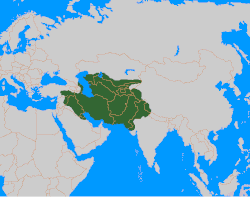Timur seated (earliest known portrait), Timurid genealogy, 1405-1409, Samarkand (TSMK, H2152)
Autor:
1405-1409 artist
Shortlink:
Zdroj:
Formát:
858 x 1371 Pixel (1406019 Bytes)
Popis:
Timur seated, Timurid genealogicy, 1405-1409, Samarkand (TSMK, H2152)
- "167 HUSAIN B. ALI SHAH (active early fifteenth century) Turko-Mongol Genealogy, probably for Khalil Sultan 1405-9 , Samarkand (?), Uzbekistan Opaque pigment and ink on paper, 68 × 50 cm ( folio ) Topkapı Sarayı Muzesi, Istanbul, H.2152" Turks: A Journey of a Thousand Years, 600-1600, David J. Roxburgh, Royal Academy of Arts (Great Britain) Harry N. Abrams, 2005, p.418
- "From the collection of the Topkapı Saray Library (...) an early fifteenth-century copy of Turco-Mongol Genealogy by Husain b.ʿAli Shah (probably Samarqand, c. 1405–1409) with round-shaped illustrations of rulers" The Diez Albums: Contexts and Contents, BRILL, 2016, p.274
- Turco-Mongol genealogy depicting Timur and his sons 1405-1409 [1] The Persian Album, 1400–1600, David J. Roxburgh, Yale University Press, 2005, p.92
- "To the best of my knowledge, the earliest portrait of Timur can be found in a genealogical scroll (Istanbul, Topkapı Palace Museum, H. 2152, fols 32-43"), produced shortly after his death in Samarqand (probably under the reign of Khalil Sultan, r. 1405-1409); for a reproduction of fol. 33", see, e.g. Roxburgh 2005, cat. no. 167. It shows Timur enthroned within a round medallion in three-quarter view, kneeling with his feet hidden underneath his robe. He points with his raised right hand upwards to the ancestors of his family tree, headed by the Mongol queen Alan Qoa (now on fol. 42"; for a reproduction, see Roxburgh 2005, 197, Fig. 43) and holds a royal handkerchief in his left. Interestingly, this prototype seems to have inspired a seventeenth-century Mughal painting that has survived in one of the cropped miniatures in- corporated into one of the sixty collages made for the rocaille frames decorating the walls of the so-called Millionenzimmer in Schönbrunn Palace in Vienna (reproduced in Brinkmann et al. 2020, cat. no. 95.1). It depicts Timur in almost identical kneeling posture and dressed in a similar way, with a bundle of feathers adorning his helmet too, but without the handkerchief in his left hand. However, the colours are different, and a few elements are added, such as the golden nimbus, the elements of armour on his forearms, and the parasol placed above his head. The royal parasol in connection with Timur wearing armour started appearing in illustrations of the Zafarnāma (Book of Conquests) manuscript from 1436, commissioned by Timur's grandson Ibrahim Sultan (1394-1435); for two examples from that manuscript showing Timur on horseback with an attendant carrying the parasol, see Roxburgh 2005, cat. nos 169 and 171. The iconography of Timur on horseback was taken further by Bihzad in one of his paintings in the Garrett Zafarnāma of 1467/1468 (Baltimore, John Hopkins University, Garrett Library, Gar. 3 c. 1, fol. 283), which later inspired an album painting by the Mughal Govardhan of c. 1620-1640 (Dublin, Ches- ter Beatty Library, In 07A.3), inscribed by Emperor Jahangir (r. 1605-1627): 'They say that this is a likeness of His Highness şāhibqirān[,] written by Jahangir Akbar Shah.' The earliest Mughal paintings of Timur can be found in a manuscript of the anonymous Tārīkh-i Khāndān-i Tīmūriyya (History of the Timurid House) illustrated under Akbar's reign (r. 1556-1605) in the mid-1580s. The manuscript is preserved in Patna, Bihar (Khuda Bakhsh Oriental Public Library Patna 1977, cat. no. 551). Its illustrations show Timur either on his military campaigns or kneeling on his throne-chair, always without the royal parasol." in Manuscript Albums and Their Cultural Contexts: Collectors, Objects, and Practices, Janine Droese, Janina Karolewski, Walter de Gruyter GmbH & Co KG, 2023, p.135 note 33
Licence:
Public domain
Credit:
Tento soubor byl vyříznut ze souboru
Relevantní obrázky
Relevantní články
TamerlánTamerlán byl turkický vojevůdce a krutý dobyvatel, který ve 14. století vytvořil obrovskou Tímúrovskou říši rozkládající se především na území dnešního Íránu, Turkmenistánu, Uzbekistánu a Afghánistánu s hlavním městem Samarkand. Přestože již vyznával islám, snažil se obnovit bývalou slávu Mongolské říše. Byl také zakladatelem dynastie Tímúrovců. Navzdory tomu, že se jeho obrovská říše po jeho smrti rozpadla, dynastie dále pokračovala a jeden z jeho potomků, Babur, se stal zakladatelem Mughalské říše v jižní Asii. .. pokračovat ve čtení

